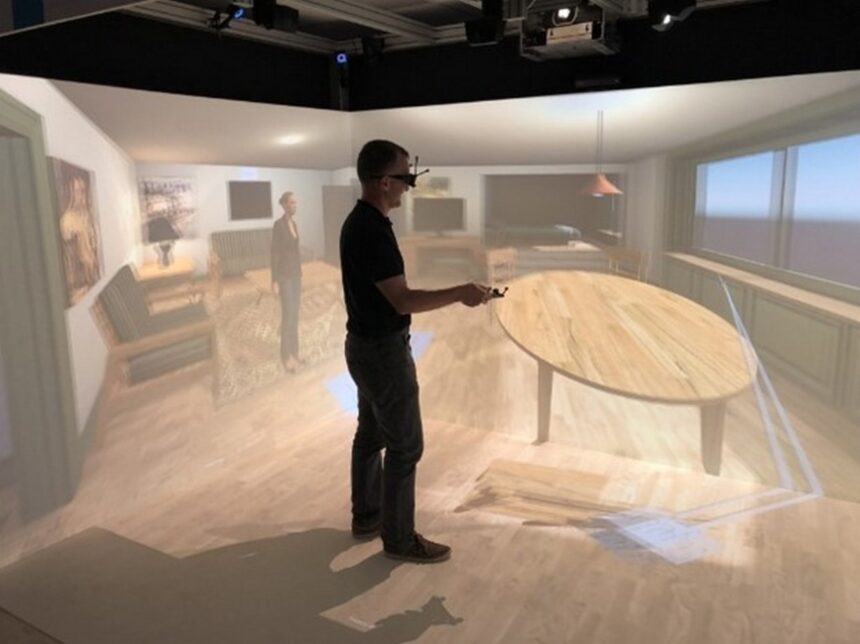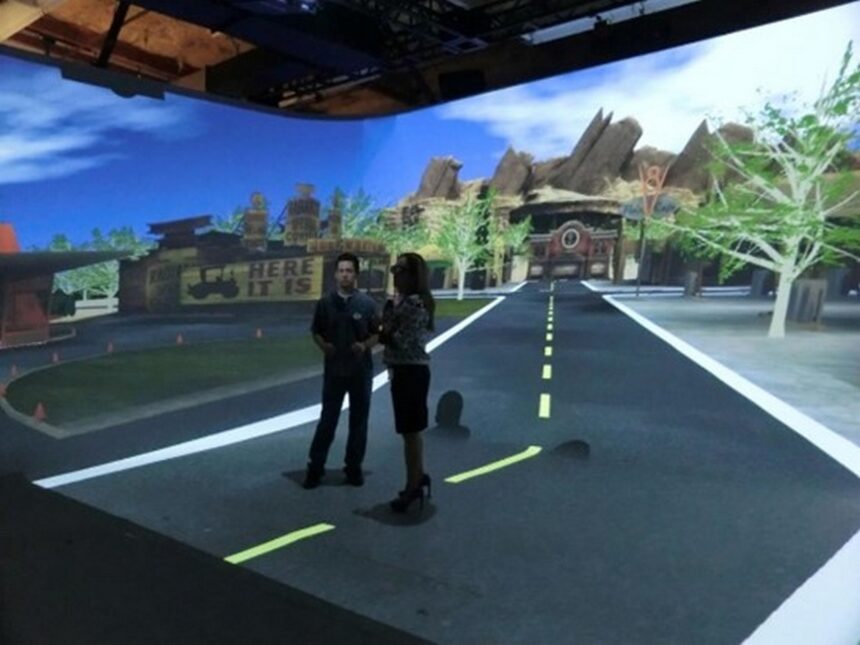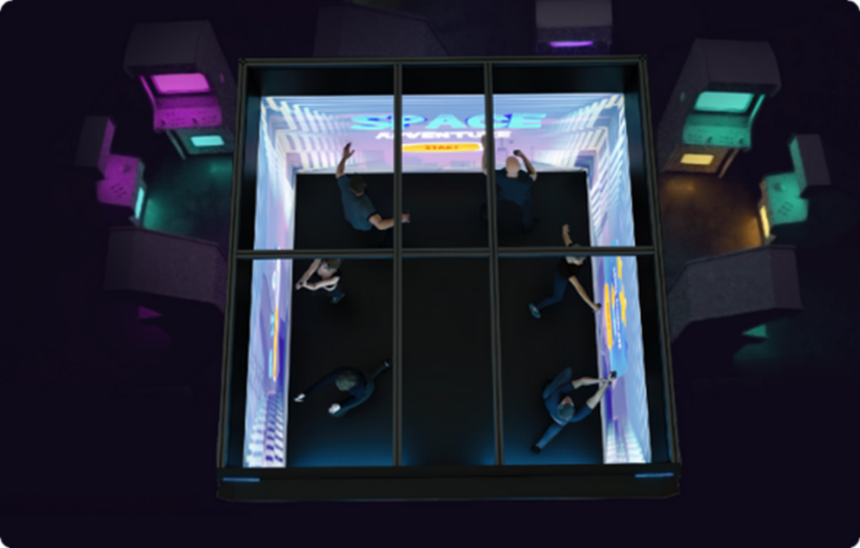Virtual Arena: Get Inside the Box - Part. 1

The Application of XR into the attractions and amusement landscape is covered by industry specialist Kevin Williams, in his latest Virtual Arena column – in this first part we look at the technology of CAVE and “Immersive Enclosures” hoping to usurp headsets.
Author: Kevin Williams
In this latest column for MIXED – and in this first part, we look at an application that can trace its roots back to the early evolution of immersive technology. Offering for the Out-of-Home entertainment landscape a brand-new attraction that places the players into the heart of the experience without the encumbrance of VR head-mounted displays.
Content
History of the CAVE
With the growth of new high performance laser projection systems, along with advancements in computer graphics. It was inevitable to develop enclosures that offered a level of immersion that opened a new field of research, beyond that of conventional virtual reality headsets. This research would be championed by the University of Illinois, Chicago, and their ‘Electronic Visualization Laboratory’ during 1992. And what would emerge would be the first “CAVE” (Computer Automatic Virtual Environment). A fully immersive environment where the walls and floor are projected onto with a representation of the virtual environment that the user can navigate and, in many cases, interact with.

Picture: Scale1Portal
This was a far more authentic means to interact with a virtual space and elevated the encumbrances of rudimentary head mounted displays. The ability to interact with the space as if physically there added a level of authenticity to the experience, employing stereographic imagery. Another benefit was the ability for multiple users, to share the same space naturally – a perfect environment for productivity.
The CAVE application would become the preserve of the laboratory and the research center, used in architecture design, training and education. While VR has fallen in and out of fashion in commercial application, the immersive environment has continued to be deployed. However, the description of the technology has evolved, kidnapped as being now part of the drive in Mixed Reality (MR) or even described as part of the Extended Reality (XR) revolution.
Whatever the descriptor, the technology of immersive enclosures, have seen their continued use in architectural design and training – as with companies like Scale1Portal and their ‘Immersive Room’ platform. As well as these environments used extensively in training, with law enforcement and military personnel, through the likes of developer VirTra and their unique ‘V-3000’ – a platform used for firearms training. The five-screen system – offering a 300-degree surrounding screen envelops the multiple-users within the virtual experience. Originally using FMV (full-motion video) captured scenarios for training, (becoming, like a high stakes ‘Mad Dog McCree’ shooting-arcade alternative).
Theme Park in a Box
The theme park industry would start to see the CAVE system as a means for immersive entertainment as well as training and design. One of the first to deploy this technology as an attraction, was The Walt Disney Company, within their embryonic ‘DisneyQuest’ facility concept (often defined as a “theme-park-in-a-box”), the first Florida venue, installed in 2000, the revolutionary ‘Pirates of the Caribbean: Battle for Buccaneer Gold’. An immersive enclosure, supporting six guests, firing the ships cannons, while one person steered the helm, controlling the ship. An immersive reimagining of the original ‘Pirates of the Caribbean’ e-ticket theme park attraction. The action viewed on a surround, four wall screen display in 3D, using active glasses. All this, with the enclosure using a special pneumatic motion system for the movement of the pirate ship.
The immersive environment offered an attractive and elegant solution to the creating of a multiple user experience, avoiding the inherent issues of using VR headsets, at the time still rudimentary. But also reflected the need for immersive attractions to offer a multiple player experience rather than the isolated singular experiences with VR.
Much of the technology developed for the Walt Disney attraction would be revived in 2012, as the theme park corporation looked towards this immersive technology, in park design and development. Walt Disney Imagineering would go on to reveal their interpretation of the CAVE, with their ‘Digital Immersive Showroom’ (DISH), offering wall-to-wall, super high-resolution (4k) projection. An environment that helped in the placing of architecture in the parks to achieve required site lines, as well as testing out ride concepts such as the initial work on the ‘Ratatouille’ and ‘Radiator Springs Racers’ attractions. The DISH has continued to evolve and is still used as an integral part of the design visualisation process for park design, allowing teams to review their work in a shared immersive space.

Picture: Walt Disney
While the placing of the users into the immersive world is achieved through the all-encompassing projection systems, there has been development to allow the user to navigate the world naturally. The ability to track the movements and gestures of the users, saw the first implementation of motion capture (MoCap) via “Computer Vision”, tracking the players movements, and representing them in the virtual world. While the console game scene saw the simplistic limitation of body movement-controllers with systems like Sony’s ‘Eyetoy’ and the Microsoft Xbox ‘Kinect’. But before this, in the amusement scene motion tracked experiences had been experimented with first, such as with the 1999 Holoplex, ‘Combatica’.
The Modern Holodeck
While many have been fixated on VR for application in the latest amusement and attractions, the allure of Immersive Environments has not diminished. For many the idea of this technology is fuelled by science fiction concepts such as the “Holodeck” from ‘Star Trek’, and with this interest the benefits of the technology have allowed it to find a way once again in the out-of-home entertainment sector. The name CAVE, dropped, to be replaced, now described as the “Immersive Enclosure”.
Much of the technology that has driven the resurgence in VR has also found its way into driving the Immersive Enclosure market. One of the main elements is the ability to track multiple users within the enclosure and their activities. The HTC VIVE Tracker is one such element. Created as a unique system married to the Lighthouse base-station platform, the tracking represents the user in the virtual environment. The system has gone through many phases of development, (originated by Valve), now applied in the immersive enclosure scene, as well as VR.
Media based technology innovator, Attraktion! – is a company that has experimented with the cutting edge of digital technology for deployment beyond theme parks. The company developed their ‘Playoke Dance & Kids Game’, a system using large screen and computer vision to create a compelling attraction. But based on this technology the company would go on to develop their ‘PlayNeo’ – an interactive game arena that has five-players using special interactive devices (‘Active Sheildz’) to interact with the virtual experience, represented on the enveloping screens of the interactive game arena.

Picture: Attraktion
And so, with the first stumbling’s the immersive enclosure sector has blossomed. The interest in immersive entertainment experiences in the theme park, family entertainment center (FEC) and location-based entertainment (LBE) market has mushroomed, and with that the application of this new technology that addresses much of the limitations that head-mounted display technology brings to the business.
One of the latest developments in this scene is from INOWIZE – launching last year their ‘QBIX’ – an amazing 13 by 13-sq.,-ft., immersive space that can accommodate six-players within the projection enclosure. The players using HTC VIVE Lighthouse controllers, through a selection of three new games, offering 60-minute experiences. This 5D platform also employing wind and vibrating floor effects. An unusual feature of the immersive enclosure system is its ability to be operated without an attendant, the players able to start their experience all unattended.

Picture: Inowize
Their interpretation of the immersive area concept was launched by INOWIZE in 2022, and already has started to ship into the entertainment facility scene. One such is the Romanian entertainment venue ‘HYPE’, who have placed the system in their location-based entertainment venue as an alternative to their more conventional VR entertainment platforms. INOWIZE having developed previously their own ‘Arkadia’ VR arena. The company now working on developing a smaller version of the system, they plan to call ‘QBIX Kids’, aimed at a much younger demographic as they define the deployment of this technology.
Japanese Amusement Mix
The Japanese amusement trade have been attempting to redefine themselves, moving away from the traditional amusement offerings towards more immersive games. This has also seen the re-development of the amusement venue business, with new brand stores. Industry legend TAITO, celebrating their 70th anniversary in amusement has been promoting their ‘X-STATION’ venue concept, which includes XR based entertainment. One of these elements is called ‘CUBE’ – a up-to-four-player Immersive Enclosure (4-meter square), building on the CAVE principle.
The platform was launched originally with a ‘Space Invaders’ homage called ‘SpaceCube’ – a shooting game for four-players in an invaders’ filled shoot-em-up inspired experience. This was followed by ‘Treasure Explorer’ – this time with the four-players, now seated on swivel chairs within an enclosure representing a virtual ride vehicle, for the players to shoot from.
Most recently TAITO has revisited the ‘CUBE’ with a unique zombie shooter called ‘Survival from Z’ – the three players now dual wielding pistols as they progress through the atmospheric wards of an abandoned an overrun hospital. This latest experience for the platform adding a 12-minute, horror-shooter, to the growing library of games.
All the above-mentioned platforms use a derivation of the HTC VIVE Tracker 3 platform. Deploying the tracker units and Lighthouse base-stations. But as we said previously, this has been and iterative process, and announced in March HTC revealed the latest incarnation, with the HTC VIVE Self-Tracking Tracker that is 50% smaller than the original unit, forgoing the need of the Lighthouse system, using SLAM (Simultaneous Localization and Mapping). Like with the original, units it will be able to be deployed in players wands and controllers within these experiences – but with the cost and operation savings of a non-base-station instillation.
This concludes the first part of our coverage of this highly versatile sector. In part two, we look at the next generation of immersive enclosures, including the deployment of exergaming and active entertainment experiences.
Note: Links to online stores in articles can be so-called affiliate links. If you buy through this link, MIXED receives a commission from the provider. For you the price does not change.